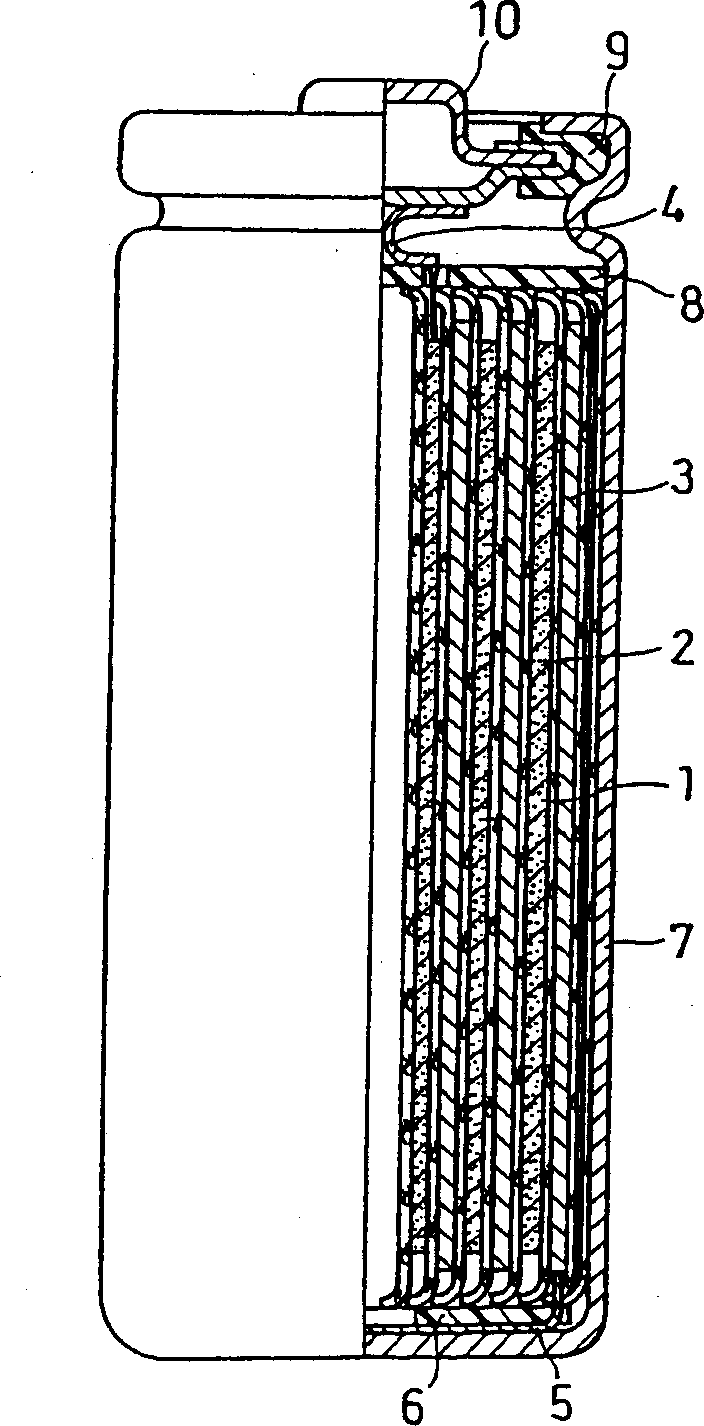Nonaqueous electrolyte secondary battery
A non-aqueous electrolyte, secondary battery technology, applied in non-aqueous electrolyte batteries, secondary batteries, non-aqueous electrolytes, etc., can solve the decline of battery charge and discharge characteristics, the influence of low temperature characteristics of ethylene carbonate, and the inability to ensure low temperature features, etc.
- Summary
- Abstract
- Description
- Claims
- Application Information
AI Technical Summary
Problems solved by technology
Method used
Image
Examples
Embodiment 1
[0065] figure 1 Shown is a cross-sectional front view of the right half of the cylindrical non-aqueous electrolyte secondary battery (18 mm in diameter, 65 mm in total height) used in this embodiment. The battery was fabricated as follows.
[0066] The separator 1 is sandwiched between the strip-shaped positive electrode plate 2 and the negative electrode plate 3, and wound several times in a spiral shape to form an electrode plate group. The positive electrode lead plate 4 made of aluminum and the negative electrode lead plate 5 made of nickel are welded to the positive electrode plate 2 and the negative electrode plate 3 respectively. Install the polyethylene resin bottom insulating plate 6 under the pole plate group, put it into the battery iron case 7 whose inner surface is nickel-plated, and spot-weld the other end of the negative lead plate 5 on the inner fixing surface of the battery case 7 . Place the polyethylene resin upper insulating plate 8 on the upper surface o...
Embodiment 2
[0085] Since vinylene carbonate (VC) causes a very rapid polymerization reaction on the negative electrode, if the amount added to the electrolyte solution is too large, excessive film formation on the negative electrode may result in a decrease in low-temperature characteristics. To this end, the VC content in non-aqueous solvents was studied.
[0086] Batteries 1C to 7C which were the same as battery 2A in the example were fabricated except that the VC content in the nonaqueous solvent was changed as shown in Table 4. That is, as the cyclic carboxylate (A), γ-butyrolactone (GBL) is used, as the cyclic carbonate (C) having no carbon-carbon unsaturated bond, propylene carbonate (PC) is used, and as the solute , using LiBF 4 , the PC content in the non-aqueous solvent is 1 vol%, the LiBF in the non-aqueous electrolyte 4 The concentration is 1.25 mol / L.
[0087] The capacity retention rates of the obtained batteries 1C to 7C in a low-temperature environment were evaluated in ...
Embodiment 3
[0092] Next, the content of propylene carbonate (PC) or ethylene carbonate (EC) in the non-aqueous solvent was examined.
[0093] Batteries 1D to 18D which were the same as batteries 2A or 4A in the example were fabricated except that the PC or EC content in the non-aqueous solvent was changed as shown in Table 6. That is, as the cyclic carboxylate (A), γ-butyrolactone (GBL) is used, as the cyclic carbonate having at least one carbon-carbon unsaturated bond, vinylene carbonate (VC) is used, and as the solute, LiBF 4 , the VC content in the non-aqueous solvent is 2% by volume, the LiBF in the non-aqueous electrolyte 4 The concentration is 1.25 mol / L.
[0094] The capacity retention rates of the obtained batteries 1D to 18D in a low-temperature environment and the capacity retention rates after high-temperature storage were evaluated in the same manner as in Example 1. The results are shown in Table 7.
[0095]
[0096] Battery
[0097]As shown in Table ...
PUM
 Login to View More
Login to View More Abstract
Description
Claims
Application Information
 Login to View More
Login to View More - R&D
- Intellectual Property
- Life Sciences
- Materials
- Tech Scout
- Unparalleled Data Quality
- Higher Quality Content
- 60% Fewer Hallucinations
Browse by: Latest US Patents, China's latest patents, Technical Efficacy Thesaurus, Application Domain, Technology Topic, Popular Technical Reports.
© 2025 PatSnap. All rights reserved.Legal|Privacy policy|Modern Slavery Act Transparency Statement|Sitemap|About US| Contact US: help@patsnap.com


